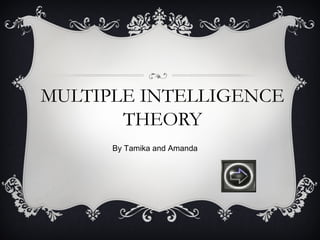
Tamikas theory
- 1. MULTIPLE INTELLIGENCE THEORY By Tamika and Amanda
- 2. THEORIST oward Gardner Known for his Multiple Intelligence Theory nvolved in the design of performance-based assessments; education for understanding; the use of multiple intelligences to achieve more personalized curriculum, instruction, and pedagogy; and the quality of interdisciplinary efforts in education.
- 3. HOWARD GARDNER raduate professor at Harvard onorary degrees from twenty-nine colleges and universities, including institutions in Bulgaria, Chile, Greece, Ireland, Israel, Italy, South Korea and Spain. 00 most influential public intellectuals in the world eceived a MacArthur Prize Fellowship in 1981
- 4. THE THEORY: AT A GLANCE ach person is smart in all seven types of intelligence. very person is stronger in some ways and less developed in others. “Heredity and genetics influence the way the brain is neurologically "wired" before birth and are contributing factors that determine the strongest types of intelligence. This is often seen in children with very strong and overt talents demonstrated at very young ages, such as Mozart, who had started to play and compose music by age five.”
- 7. CLASSROOM IMPLICATIONS -What the teacher does under this theory • Teachers can use this theory to create a curriculum based around several types of learning. • Having kids Act out a lesson through props can include bodily-kinesthetic, interpersonal, and intrapersonal intelligences. • Use technology that enhances visual/spatial, musical and linguistic learners. These can include the use of speakers on a computer to relay audio from a video. • Using manipulates (such as I pads with learning apps) can include several intelligences.
- 8. CLASSROOM IMPLICATIONS --What the students do under this theory • Recognize your own learning strengths and weaknesses according to the intelligences you learn best with. • Develop the weak parts by including learning methods that pertain to those weak parts. For example, you are music smart, but lack in number smarts. You could learn numbers through a song to learn something quickly. In order to strengthen your number smarts, focus on logical thinking and analyzing. • Students can learn through different intelligences and can develop each individual intelligence through diverse learning.
- 9. MY OPINIONS would like all of my students to develop diverse intelligences. I have the ability to do this by incorporating the intelligences into my lesson plans. I can assess what intelligences my students possess and challenge them with new ones. • “Child-centered teaching, open-ended projects, cross-curricular activities, independent study, learning center activities, multimodal work, group projects, discovery learning and authentic assessment are some techniques that embrace Gardner's theory of multiple intelligence teaching.”
- 10. CREDITS To learn more information, please visit these websites. It is recommended that all teachers learn about this theory. Picture taken from :http://www.preschools4all.com/howard-gardner.html Additional websites: http://questgarden.com/102/80/0/100505170056/index.htm http://www.ehow.com/about_4597747_what-multiple-intelligence-teaching.html http://www.edutopia.org/multiple-intelligences-schools-strategies http://www.earlychildhoodnews.com/earlychildhood/article_view.aspx?ArticleID=251 http://howardgardner.com/